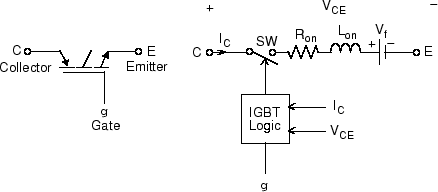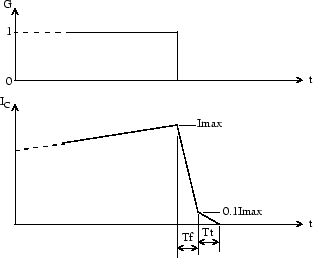IGBT
(To be removed) Implement insulated gate bipolar transistor (IGBT)
The Specialized Power Systems library will be removed in R2026a. Use the Simscape™ Electrical™ blocks and functions instead. For more information on updating your models, see Upgrade Specialized Power System Models to use Simscape Electrical Blocks.
Libraries:
Simscape /
Electrical /
Specialized Power Systems /
Power Electronics
Description
The IGBT block implements a semiconductor device controllable by the gate signal. The IGBT is simulated as a series combination of a resistor Ron, inductor Lon, and a DC voltage source Vf in series with a switch controlled by a logical signal (g > 0 or g = 0).

The IGBT turns on when the collector-emitter voltage is positive and greater than Vf and a positive signal is applied at the gate input (g > 0). It turns off when the collector-emitter voltage is positive and a 0 signal is applied at the gate input (g = 0).
The IGBT device is in the off state when the collector-emitter voltage is negative. Note that many commercial IGBTs do not have the reverse blocking capability. Therefore, they are usually used with an antiparallel diode.
The IGBT block contains a series Rs-Cs snubber circuit, which is connected in parallel with the IGBT device (between terminals C and E).

The turnoff characteristic of the IGBT model is approximated by two segments. When the gate signal falls to 0, the collector current decreases from Imax to 0.1 Imax during the fall time (Tf), and then from 0.1 Imax to 0 during the tail time (Tt).

Assumptions and Limitations
The IGBT block implements a macro model of the real IGBT device. It does not take into account either the geometry of the device or the complex physical processes [1].
Depending on the value of the inductance Lon, the IGBT is modeled either as a current source (Lon > 0) or as a variable topology circuit (Lon = 0). The IGBT block cannot be connected in series with an inductor, a current source, or an open circuit, unless its snubber circuit is in use.
The inductance Lon is forced to 0 if you choose to discretize your circuit.
Ports
Input
Output
Conserving
Parameters
References
[1] Mohan, N., T.M. Undeland, and W.P. Robbins, Power Electronics: Converters, Applications, and Design, John Wiley & Sons, Inc., New York, 1995.
Extended Capabilities
Version History
Introduced before R2006a
See Also
GTO | Mosfet | Three-Level Bridge | Thyristor